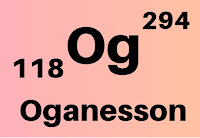Posts
Showing posts with the label The element with highest atomic number till discovered
The element with highest atomic number till discovered
- Get link
- X
- Other Apps
By
K. Pratap
-

Oganesson: The element with highest atomic number Based on the origin and method of creation, chemical elements are classified into natural or synthetic elements. Natural elements naturally exist on the earth and in the universe, formed through natural processes such as fusion reactions in stars, supernova explosions and radioactive decays. Hydrogen, oxygen, nitrogen, iron, gold, urannium are the examples of natural elements. On the other hand, synthetic or artificial elements are those created artificially by humans by nuclear reaction or particle accelerator. These do not occur naturally on earth and are created in laboratory. Synthetic elements are typically created by bombarding a target nucleus with high-energy particles to induce nuclear reactions. These reactions result in the formation of new, heavier elements. Technetiu, Promethium, Americium are some examples of synthetic elements. The matter of discussion in this article, the element Ogane...